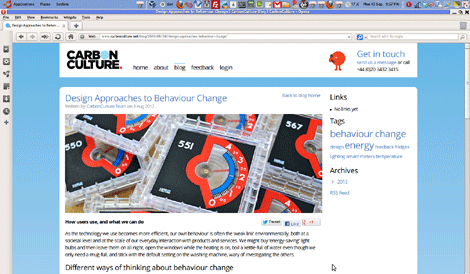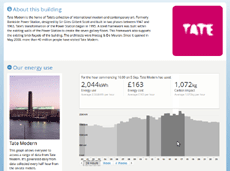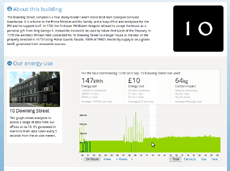
It’s been quiet here, for reasons which will be explained later, but in the meantime I should mention that CarbonCulture (with whom I’ve been working for the past two years as part of the TSB-supported EMPOWER collaboration) has a new blog.
In anticipation of the forthcoming public launch of the CarbonCulture product, we’re introducing some background on behaviour change approaches, energy use and environmental impact. The first few posts (as of today) introduce:
- The possibilities of a design approach to behaviour change
- Identifying energy waste
- Our use of participatory design
- Energy literacy
- Imagining energy
Your comments are very welcome. Over the next few months we’ll build up the story of what we’ve done — the approaches we’ve taken and what we’ve learned. There’s some further background in this article from Public Sector Sustainability by Luke Nicholson, and a paper I presented at BECC 2011.
My jobs as research fellow (for WMG) and research assistant (for Brunel) on the project have now come to an end, but I’m continuing to provide some input to the project, as well as writing up some papers based on what we’ve learned (so far, a journal paper and a conference paper).
I’m proud to have been associated with what is one of the most empathy-driven user-centred behaviour change projects out there: a fascinating, blend of contextual user research, rapid iterations of new features and approaches, adapting to the needs and interests of a whole range of stakeholders, and getting to apply lots of the ideas that fed into Design with Intent in practical settings and seeing how effective they really are.


Background to the project
CarbonCulture is a research-driven software platform designed to increase staff engagement in more sustainable behaviour at work, in areas such as HVAC and thermal comfort, building occupancy, transport modes and food choices. CO2 emissions from non-Âdomestic buildings, mainly workplaces, make up 18% of the UK’s carbon footprint, and a combination of technology advances and behaviour change has the potential to make significant impact.
Funded by the Technology Strategy Board’s Low Impact Buildings platform, Brunel Design at Brunel University and WMG at the University of Warwick have been working with More Associates to develop and trial CarbonCulture.
With the Department of Energy & Climate Change’s offices in Whitehall as a pilot site, we have been applying methods from user-Âcentred design practice to understand diverse users’ priorities, mental models of energy and decision-Âmaking heuristics, and incorporating these insights into the development of the platform. The project comprised an ethnographic research phase, participatory design, and iterative trials; we’ve been both providing academic research input to the development of CarbonCulture, and using the platform itself as a research tool.
CarbonCulture also provides publicly accessible energy displays (both near-real-time and summary) for a number of major public buildings in London, including Tate Modern, 10 Downing Street and the Cabinet Office.

